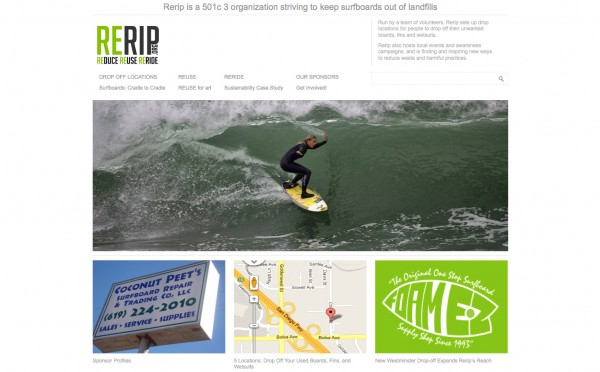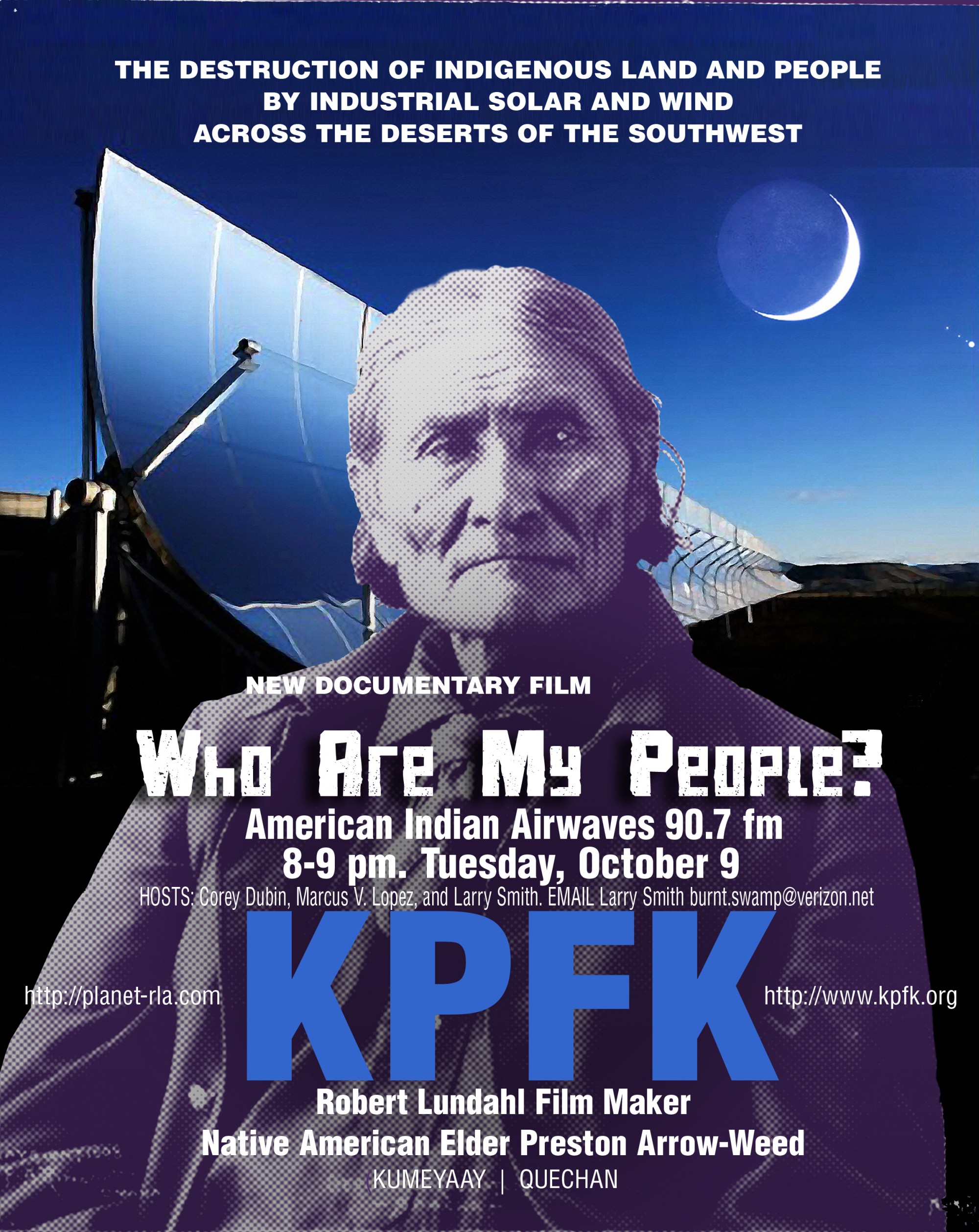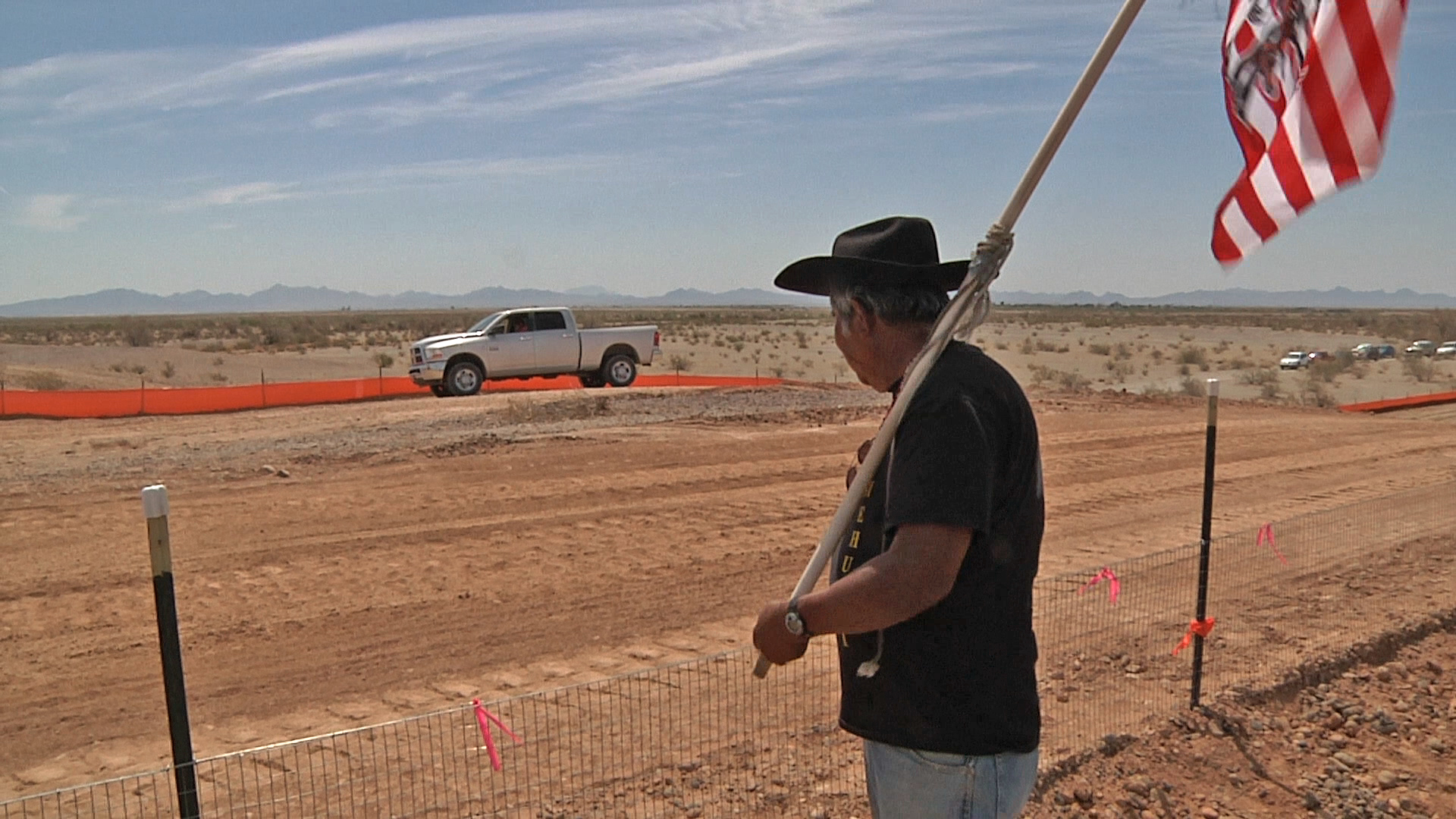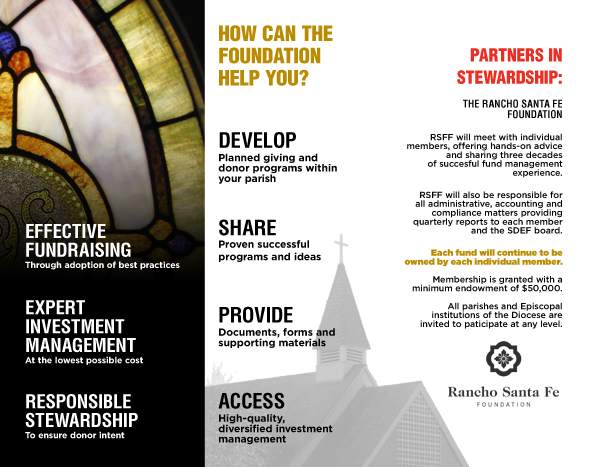Category Archives: blog
FOR IMMEDIATE RELEASE
CONTACT:
RL | A
Public Relations and Public Policy Communications
P.O. Box 429
Solana Beach, CA 92075
415.205.3481, robert@studio-rla.com
NEW FILM REVEALING THAT AMERICA’S CULTURAL TREASURES ARE SLATED FOR DESTRUCTION, TO PREMIERE SATURDAY, 9/13 IN JOSHUA TREE, CA
“Who Are My People?” Reveals Over 20 Rare And Ancient Sites Endangered by Solar Development in the Mojave Desert
When Filmmaker Robert Lundahl began to explore Native American culture in the Mojave and Colorado Deserts in 2010, he did not realize many of the sites to which he would gain unique and unimpeded access might soon be destroyed.
“I’d been interested in the Indigenous history of North America for quite some time, and my previous films had revealed ancient knowledge misunderstood by today’s society. When a colleague suggested a visit to the Blythe Intaglios, it opened up a new world of understanding of America’s Cultural Treasures, their origins and context”, says Lundahl.
The Blythe Intaglios are giant Earth drawings of human forms, geometries, and pictorial representations that embody the world-view of tribal communities and cultures, which have co-evolved with and within desert ecosystems for thousands of years. The concentration of geoglyphs, petroglyphs and other human-made Earth Images, in and around Blythe, California, along the Colorado River is rich and varied.
“A thousand years ago, the Colorado River Valley was lush and green, akin to the Egypt’s Valley of the Nile, or Mesopotamia’s Tigris and Euphrates. It was a sustaining ecosystem during the global warming period following the last ice age. As a result, there was and is a concentration of Indigenous peoples who make the area home, Lundahl explains. The flood plain remained productive well into the last century, before dams on the river channelized the flow and eliminated the flooding that had supported higher concentrations of birds, game and indigenous agriculture.
Today’s tribal people, who still live along the Colorado River, remember. Their oral history traditions, and spiritual connection with the land remain strong today. The threat comes from the construction of large-scale industrial solar energy plants, on, around, and near sites that tribal peoples consider sacred.
The Colorado River Indian Tribes (CRIT) has staunchly opposed several projects in the Riverside East solar zone.
Dennis Patch, the tribes’ chairman, said in comments submitted to Riverside County and the federal Bureau of Land Management that CRIT members “tell stories and sing songs related directly to the area where the Projects are proposed, and they consider the plants, animals, and traditional gathering places that the Projects would affect to be sacred.” “The petroglyphs, traditional song trails, and other archaeological sites that surround the area tell of their ancestors’ existence,” he said. “The destruction of these landscapes risks the severance of the Tribes’ connection to their past.”
“Who Are My People?” four years in the making, explores the sites, their spiritual connections, and choices today’s society must make regarding energy production and behaviors in another, more modern era of changing climate.
“Who Are My People?” premieres at the Astronomy Arts Theater, in Joshua Tree, California, near Palm Springs, in the evening — under the stars — on Saturday, September 13. Doors open at 7:00 p.m. Program begins at 7:30. There will be music, speakers, and food. The filmmaker and Indigenous elders will be present. Donations are accepted and appreciated.
The Astronomy Arts Theater is located at 2601 Sunfair Rd., Joshua Tree, CA 92252.
Venue information: Joshua Tree Astronomy Arts Theater.
Email Joshua Tree Astronomy Arts Theater
PRESS | REVIEWS Who Are My People? https://planet-rla.com/press-who-are-my-people/
PURCHASE DVDS FOR HOME USE https://planet-rla.com/purchase-dvds-for-home-use-2/
PURCHASE DVDS FOR SCHOOLS AND LIBRARIES (EDUCATIONAL/INSTITUTIONAL LICENSES) https://planet-rla.com/purchase-dvds-for-libraries/
###
Who Are My People? Trailer from Robert Lundahl on Vimeo.
Originally Published in Native News Network
By Robert Lundahl
Blythe, CA, November 12, 2012 — La Cuna de Aztlán Sacred Sites Protection Circle, a Native American cultural protection group, submitted comments recently on the Proposed Rio Mesa Gen-Tie project. And, what could have been a dry and technical public scoping meeting in late September following, was not, for two reasons. For one, the objections of Native Americans to the project were dramatically expressed, described by Reverend Ronald Van Fleet, a Mojave Elder and descendent of the last Traditional Mojave Chief, Peter Lambert.
The second is that Van Fleet, the embodiment of California’s “living history” has opened the door to a new, old vision of what it means to be a Californian. For the very beginnings of the state’s identity and history are here, in the place at the foot of the Mule Mountains, where Brightsource Energy has proposed development of two 250 megawatt (nominal) solar power plants (500 megawatts nominal combined) in California’s Riverside County.
According to Patricia Figueroa Robles, Chair of La Cuna de Aztlán Sacred Sites Protection Circle Advisory Committee, K. Kaufman’s recent article in the Desert Sun catalogs obstacles to the successful completion of the project. http://www.mydesert.com/article/20121024/BUSINESS0302/310240036/Issues-plague-BrightSource-solar-project
But the deeper vision spans generations and even centuries for a look back at a time before California was a state. Or even part of the country, as it exists today. California became the 31st state in 1850, but some of the families that were prominent at and before that time still walk with us, such as Van Fleet’s. Van Fleet explains that according to his Mojave oral history, the Creator, Mastumho, with his magic wand, stirred the contents of a three legged pot, or “Molcajete Bowl” and he threw the contents behind him, thus creating the Milky Way, the entire universe, water, and air. When he finished, he placed the empty pot upside down on the Earth, with the three legs up, crating the three peaks, known as “Hamock Avi” in Mojave language.
While The Mojave, of Hokan speaking peoples, trace the creation of the universe to this place, in the tradition of Uto-Aztecan peoples, the Mule Mountains display the image of a sleeping female giant, or Amazon, according to Chemehuevi Cultural Monitor and La Cuna Sacred Sites Protection Circle founder Alfredo Acosta Figueroa. Figueroa himself, a descendant of Early California Governor José Figueroa, Mexican territorial Governor of Alta California from 1832 to 1836, describes, “The Mule Mountains also represent the “Giant,” “Calafia,” with which the state name is associated. When looking West from the Palo Verde Valley, her image is seen as a profile in the shape of the Mountain ridges.”
The place names Calafia and California derive from “Calli,” meaning “House” in Nahuatl language. The name “California” for example derives from an amalgam of the words “Calli” and “Fornax”, meaning “Hot” and “House.” Nahuatl is spoken by a variety of peoples from the American Southwest to Mexico City. There are over 6 million Nahuatl speakers.
The history of the migrations of peoples across a borderless Southwest pre-1850, is recorded in “Book of the Hopi,” edited by Frank Waters and Oswald White-Bear Fredericks, in the place names and historic maps of the region, and in the Codexes, writing from original Aztec sources by conquering scribes, priests and generals of Spain in the retinue of Cortez. The Codexes are now located in museums around the world.
The Bureau of Land Management’s investigation has designated the Mule Mountains as an Area of Critical Environmental Concern (ACEC) and is included in their maps because this area has an abundance of geoglyphs, petroglyphs, cremation/burials sites, major trails and many other indigenous ritual artifacts.
###
http://eastcountymagazine.org/node/11154
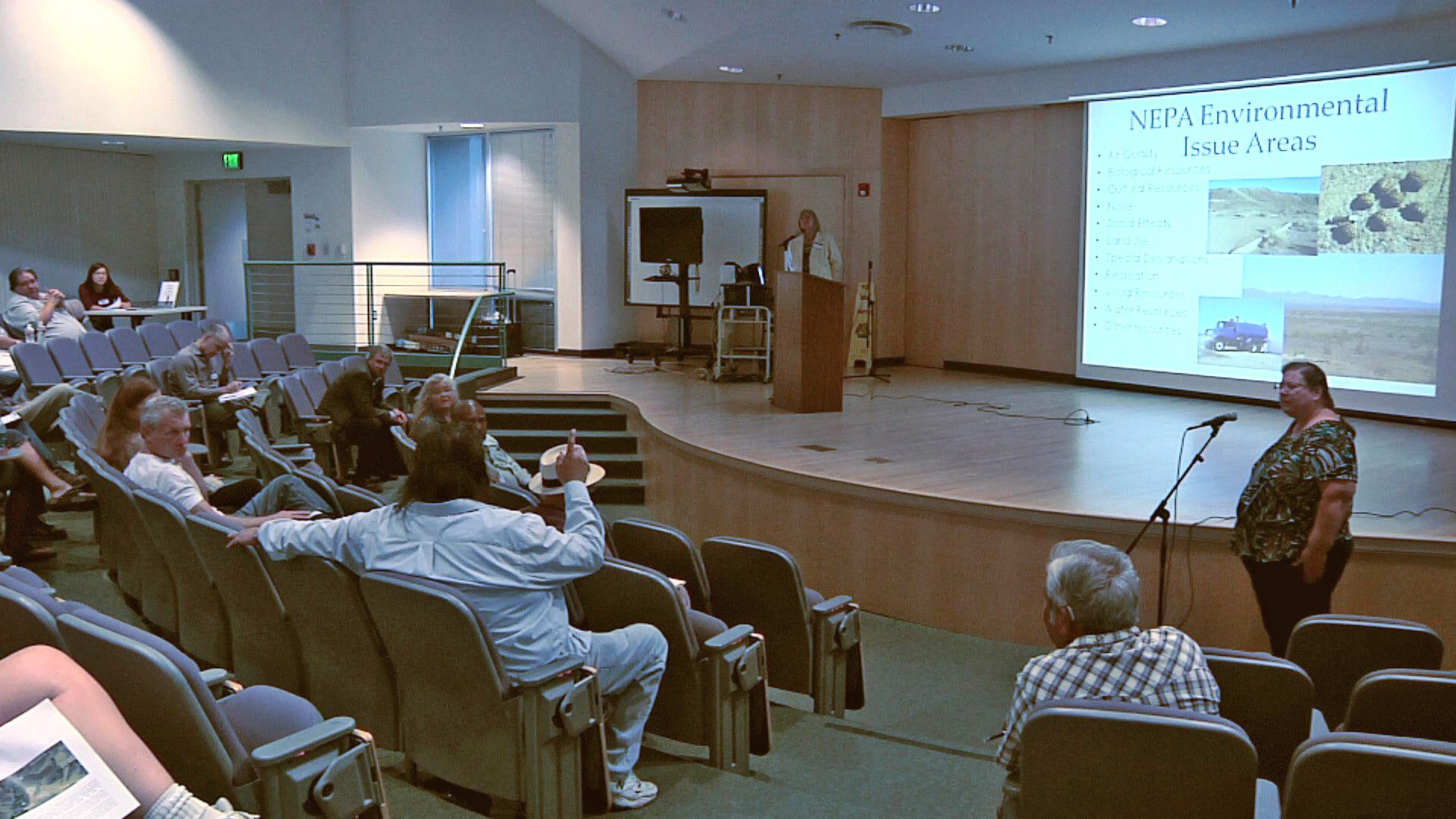 BLISTERING DESERT SOLAR MEETING: DESTRUCTION OF NATIVE AMERICAN SACRED SITES AND LACK OF CONSULTATION DOMINATE
BLISTERING DESERT SOLAR MEETING: DESTRUCTION OF NATIVE AMERICAN SACRED SITES AND LACK OF CONSULTATION DOMINATE
BLM Begins Rio Mesa Project EIS Process to Strong Opposition Over Desert Solar Siting
Story and photo by Robert Lundahl
September 17, 2012 (Blythe, California)–The Bureau of Land Management scoping meeting for the Rio Mesa Solar Plant outside Blythe, California likely caused heartburn for the BLM, applicant Brightsource, and related subcontractors and agencies last Thursday.
Time and time again Native Elders stood up to declare concerns and articulate potentially unresolvable conflicts of values, goals, and process that have the potential to devastate Obama Administration hopes to build large solar across the deserts of California and the West.
BLM representative Lynette Elser declared the “government to government consultation process,” required by Section 106 of the National Historic Preservation Act of 1966, “began for the Rio Mesa Project in November 2011.” When questioned by Chemehuevi Elder and tribal member Phil Smith, Elser could not recall which tribes had been involved in discussions. She said BLM Associate Field Manager Holly Roberts would also not be able to recall. (See Video Press Release Supplement: https://vimeo.com/49510568).
Ft. Mohave Tribal Member and Mohave Indian Nation Traditional/Hereditary Chief, The Reverend Ronald Van Fleet, stated that he did not know of any requests for consultation at the time of the 9/15/2012 meeting, asking, “Who are we to trust here?”
The BLM is obligated by the federal government’s “Trust Relationship” (holding lands and cultural resources in trust) with tribes, to follow the rules they made.
“An incoherent or non-existent Section 106 process undermines that trust relationship, and is helping to unravel Obama Administration solar policies across the West,” says Cory Briggs, Attorney for La Cuna de Aztlan Sacred Sites Protection Circle. La Cuna filed complaints in late 2010 against the Departments of Interior and Energy, against the BLM, and against several applicant companies, including Brightsource, which had become associated with Robert Kennedy Jr. and VantagePoint Partners.
“We said no,” declared Reverend Van Fleet, “When is it going to get through your head?” A million dollars is nothing, do we have to fine you a billion dollars for violating one of our cremation sites, or 10 billion dollars? I think that’s a pretty number. Do we have to go to court to do that? That’s the only thing you understand is the money.”
Van Fleet was joined by 15 Mohave Nation Elders and Councilmembers, and by Elders and Councilmember’s from the CRIT Indian Nation (Colorado River Indian Tribes), which includes Hopi, Navajo, Chemehuevi, and Mohave peoples. CRIT Councilperson Amanda Barrera noted that the National Congress of American Indians, NCAI, adopted a resolution introduced by CRIT, opposing the Department of Interior Fast-Track Policies of Renewable Energy Projects on Ancestral Homelands http://www.ncai.org/resources/resolutions/opposing-the-department-of-int….
La Cuna’s Founder, Sr. Alfredo Acosta Figueroa, a Chemehuevi Nation Cultural Monitor, added that the siting of the Rio Mesa facility is on and near areas sacred to Uto-Aztecan peoples. The three peaks close to the site are called Cali, which is from the Nahuatl language and reflects the origin of the name of the State of California.
Additionally, he states, the recent discovery of hundreds of acres of mammoth fossils on the Rio Mesa site, and the BLM’s continuation of the scoping process regardless, is inconsistent with the recent establishment of a National Monument in the Las Vegas Valley, where Nevada Senator Harry Reid helped to protect similar deposits.
“They can declare a National Monument anywhere they want, said Figueroa.”
ReRip.com Goes Live
Rerip is a 501c3 organization striving to keep surfboards out of landfills. RL | A created a WordPress blog from a theme by Marios Lublinski. It’s a minimalist theme, sophisticated and interactive with enough white space to give clarity. The site has a fair amount of images from the neighborhood here in Solana Beach and beyond. The blog features all major share functions and is a “connector” between ReRip’s ideas and the world. We support ReRip and their mission. http://www.rerip.com
Wolf Tracker Optics
Tune in to KPFK this Tuesday evening at 8:00 p.m. (Streaming http://www.kpfk.org/listen-live.html) for a special pledge break event featuring Film Maker, Robert Lundahl discussing his new feature documentary, “Who Are My People?”
“Hasty decisions allowing industrial solar and wind to be sited on sacred lands have been destructive to Native American communities. The federal government and the Bureau of Land Management get an “F” in making renewable energy make sense.”
-Director, Robert Lundahl
Robert will be joined by Native American Elder and Storyteller, Preston Arrow-Weed (Kumeyaay/Quechan), who appears in the movie.
A limited number of “Who Are My People?” DVDs are offered as pledge special bonus gifts for your support of KPFK.
Home Video and Educational DVDs can be purchased here: https://planet-rla.com/purchase-films-by-robert-lundahl/
Thank you for supporting the cause and spreading the word!
Visit our website at https://planet-rla.com





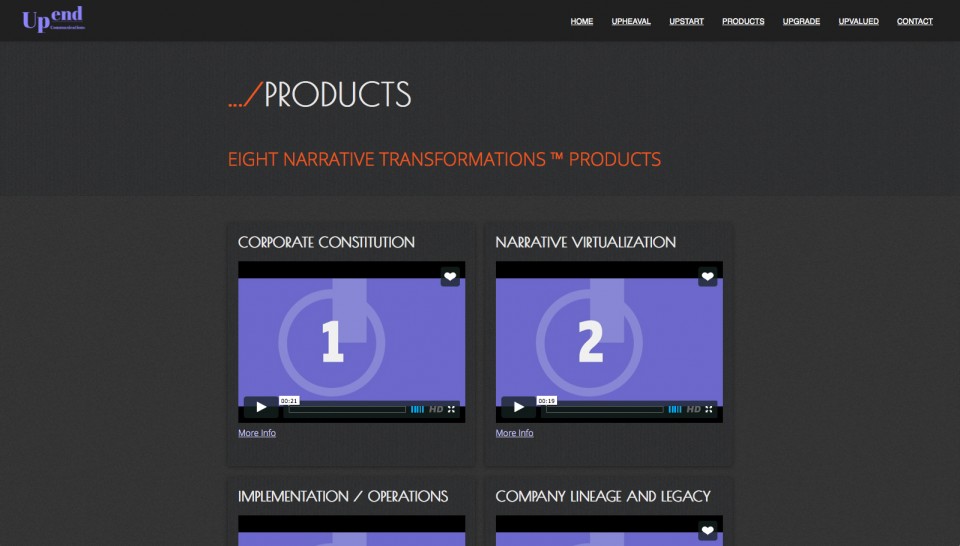
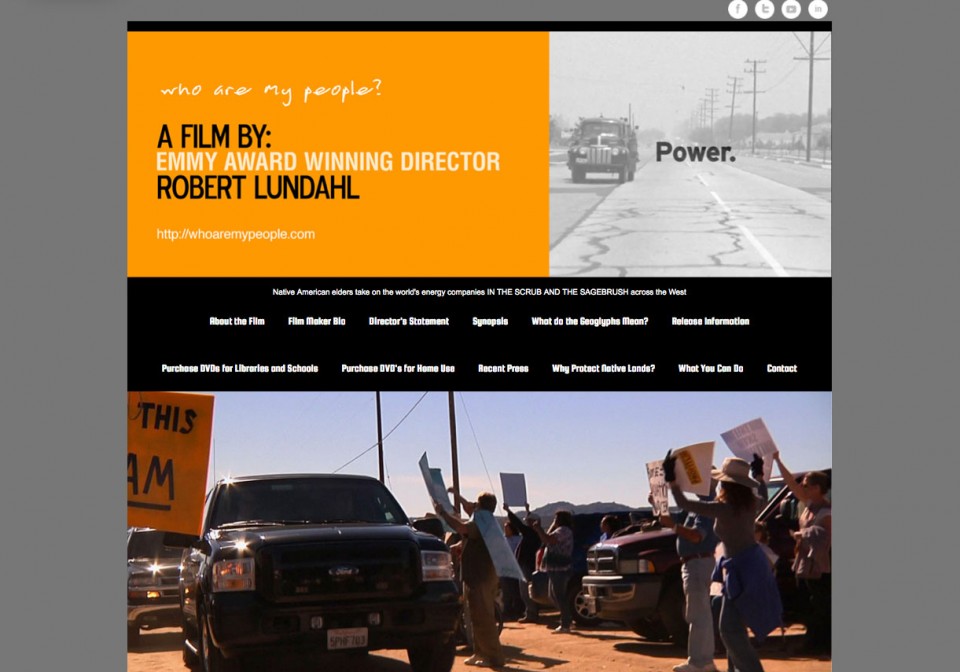
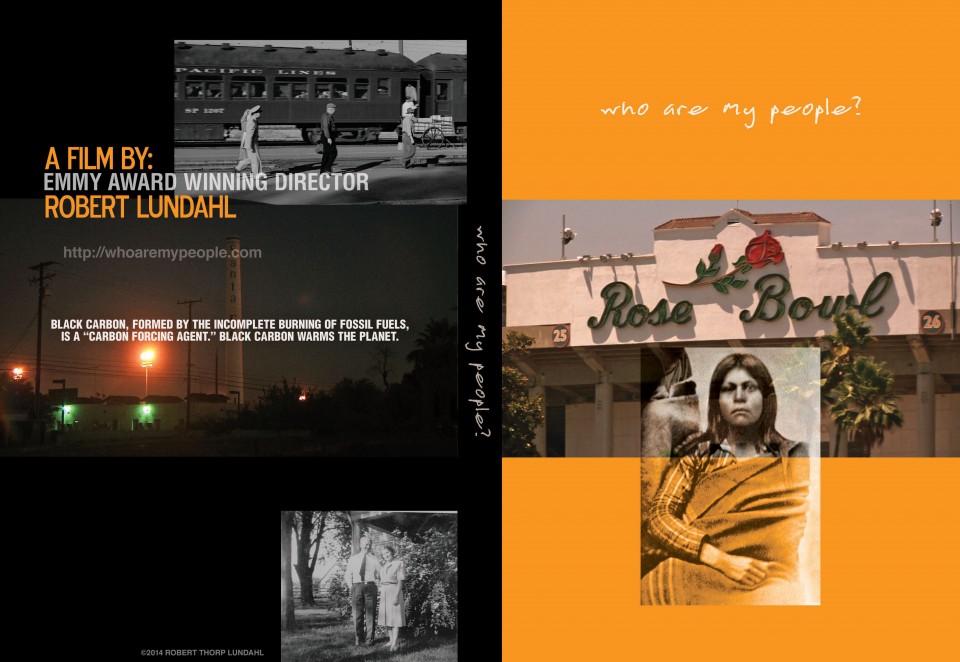
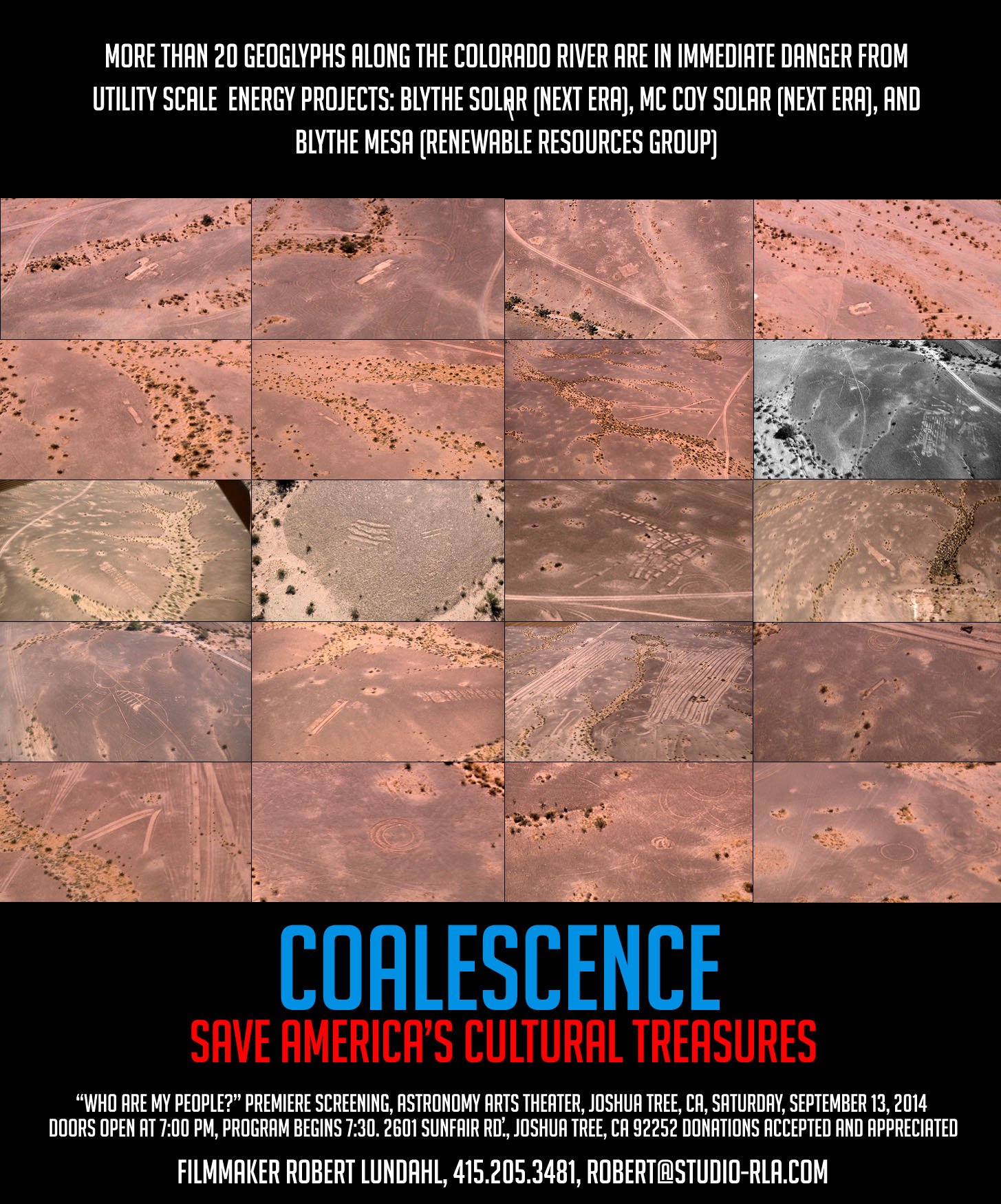
![ Originally Published in Native News Network By Robert Lundahl Blythe, CA, November 12, 2012 — La Cuna de Aztlán Sacred Sites Protection Circle, a Native American cultural protection group, submitted comments recently on the Proposed Rio Mesa Gen-Tie project. And, what could have been a dry and technical public […] The Mule Mountains: California’s Origins, Forgotten by Most, Face the Bulldozer.](https://planet-rla.com/wp-content/uploads/2012/11/rio_mesa_8x4.5-980x551_c.jpg)

